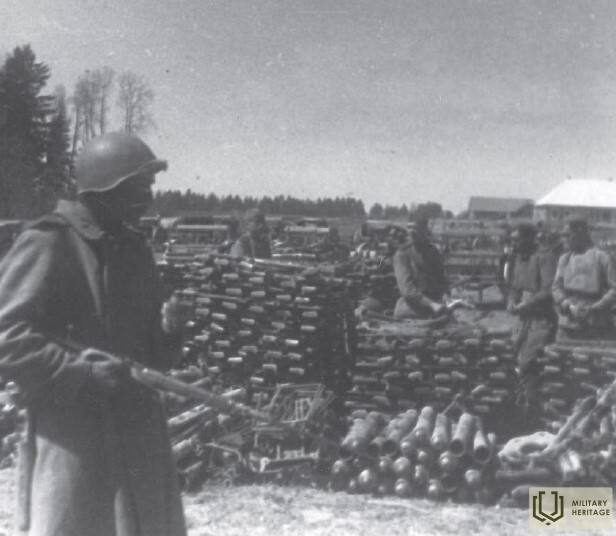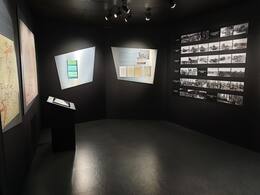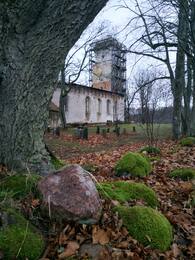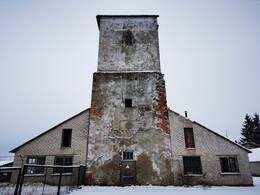Ezerieša Jāņa Miesnieka atmiņas par 2. pasaules kara beigām Ezerē
The repository of cultural history and regional research materials of the lake "Muitas nams" has been established in a historically important building. On May 8, 1945, the act of capitulation of the units of the Nazi German army surrounded on the Kurzeme front was signed here.
Jānis Miesnieks (b. 1930), a former resident of Ezer, shares his memories about the events of that day.
The spring of 1945 came and the front line was already near Saldus. All the neighbors also returned from the forced evacuation in Lithuania. Due to the coincidence of fate, I became a witness of an important historical event. One day in May, a guy from Mažeikikai came to receive payment for the work done during the summer. We dragged the corresponding bags of grain into the horse-drawn cart, which was entrusted to the old, much experienced mare Irma to pull. The movement could only take place along the very narrow side of the highway, because in the middle there was a deep, hollow furrow driven out by heavy machinery. It was already afternoon when we left "Zakai" for Ezeri. The pace at which we were moving forward might have been about 3 km per hour. However, the army road patrol did not let us cross the Vadakste bridge to Mazeikikai in Ezere. The next bridge across the Vadakste was near Laižuva, and instead of 13 km, the road to the destination became 33 km long. After driving a few kilometers, like phantoms from another dimension, several excellent black limousines were moving slowly towards us along this ruined road. You could clearly see the people sitting in the cabin - high-ranking commanders of the Red Army, but at the very back, a German officer with characteristic tall uniform hats was sitting. On the way we also heard quite loud noises from the front. But when the night came on the way, the entire edge of the front was burning with one fire, a salvo of rockets, the tracks of shining bullets decorated the edge of the sky like strings of beads. Beautiful, if only without the price of blood. It was obvious that the inferno in my Kurzemīte had started to boil... The darker it became, the more intensively the fire from the front lit up the outskirts.
We reached Mazeikis at sunrise. It turns out that a modest country house was the end point of our long, worn-out road, made with considerable effort and filled with engaging events. Here the cargo was unloaded, as well as received, it seemed, mind-boggling news: the war is over!!! Yesterday, May 8, the Germans signed the capitulation in Ezere.
With the empty cart, I immediately went straight home through the Lake, dozing from exhaustion. In less than a day, the situation in the world had changed radically: when I left home yesterday, there was still a state of war, but already on the morning of May 9, peace reigned. In the lake behind the Vadakste bridge, I passed the former customs house, where yesterday the authorized representatives of the Wehrmacht had signed the act of unconditional capitulation of the armies of the Kurzeme encirclement front. It was for this reason that the road over the bridge was closed yesterday and fate gave me the opportunity to see the participants involved in the event and the surge of emotions at the front on the first night of peace. With this, the hellish cauldron in the Kurzeme cauldron had stopped boiling. When I returned to "Zaķi" on the morning of May 9, the army liaison officers living in our house were in a complete frenzy...
Zugehörige Objekte
Ezeres kultūrvēstures un novadpētniecības materiālu krātuve „Muitas nams”
Ezeres kultūrvēstures un novadpētniecības materiālu krātuve “Muitas nams” atrodas Ezerē tiešā šosejas Saldus - Mažeiķi tuvumā pie Latvijas - Lietuvas robežas. Šajā ēkā 1945. gada 8. maijā tika parakstīts Kurzemes katlā ielenkto vācu karaspēka daļu kapitulācijas akts. Ar to tiek uzskatīts, ka Ezerē faktiski beidzies 2.Pasaules karš.
1945. gada 7. maijā Vācijas pilsētā Reimsā plkst. 02.41 pēc Viduseiropas laika Trešais reihs parakstīja kapitulāciju Sabiedroto priekšā. Bezierunu kapitulācija stājās spēkā 1945. gada 8. maija plkst. 23.01 pēc Viduseiropas laika. 1945. gada 7. maija rītā Ļeņingradas frontes komandieris maršals Leonīds Govorovs nosūtīja ultimātu armiju grupas “Kurzeme” vadībai ar prasību nolikt ieročus, dodot 24 stundas laika atbildes saņemšanai.
8. maija plkst. 07.00 un 08.35 pēc Maskavas laika Ļeņingradas frontes štābs uztvēra radiogrammas atvērtā tekstā ar informāciju, ka armiju grupa “Kurzeme” pieņem kapitulāciju. Abas puses saskaņoja radiosakaru kārtību un vienojās, ka 8. maija 15.00 uz Skrundas – Pampāļu ceļa pie Sūnu mājām Armiju grupas “Kurzeme” pārstāvis ģenerālmajors Otto Rauzers šķērsos frontes līniju. Sarunas sākās plkst 18.00 un notika Ezerē, muitas namā uz Latvijas – Lietuvas robežas. Dokumentu parakstīja 8. maija plkst. 22.05 un tā paredzēja kapitulācijas kārtība, ieroču savākšanas punktus, iesniedzamo dokumentu un informācijas apjomu un citus praktiskus pasākumus.
Ekspozīcija ir daudzslāņaina un domāta plašam interesentu lokam. Ārzemju apmeklētājiem saturs ir pieejams arī angļu valodā, taču, lai uzrunātu vēstures entuziastus ekspozīcijas satura padziļinātajā daļā ir iespēja atrast specifisku, detalizētu informāciju par karojošo pušu armijas vienībām Kurzemē Otrā pasaules kara beigās.
Ar mākslinieciskiem līdzekļiem, piemērotu krāsu gammu, kauju shēmām, video liecībām, aculiecinieku atmiņām, fotogrāfijām no kara pēdējām dienām, kā arī unikālu vēsturisko fona informāciju ekspozīcija ieved apmeklētāju saasinātā stāstā par karadarbības sākumu un beigām Kurzemē. Tā uzsvērs arī karadarbības sekas mūsdienās, kur Otrā pasaules kara liecības nav tikai vēsture, bet arī ikdienas realitāte.
Muitas namā atrodas citas ekspozīcijas no Ezeres pagasta senvēstures līdz šodienai, tai skaitā par ezernieku vaļaspriekiem.
Punaarmee vangide filtratsioonilaager Grieze'is ja Grieze'i kirik
Grieze asub Läti-Leedu piiril, kus Vadakste jõgi suubub Venta jõkke. Grieze kirik ehitati 1580. aastal, kuid kihelkond eksisteeris juba enne 1567. aastat. Kirikut ehitati mitu korda ümber - 1769. aastal, 1845. aastal ja 1773. aastal paigaldati esimene orel. Nii altarimaja kui ka kaks kirikukella on erinevatel põhjustel kadunud.
Kiriku aias on kalmistu, kuhu on maetud kirikusse kuuluvaid inimesi ja aadlikke inimesi. Üks neist on Grieze organist Friedrich Baris ja tema abikaasa Charlotte, kellele on püstitatud mälestusmärk kirikusakristi ees. Kiriku lõunaküljele on maetud 32 Põhjasõjas langenud Rootsi sõdurit. Kalmistul asuvad ka 110 esimeses maailmasõjas hukkunud saksa sõduri hauad, kellele 1930. aastal püstitati mälestusmärk.
Teise maailmasõja ajal sai kirik kannatada, kui 1944. aasta oktoobri lõpus venitati rindejoont mööda Venta jõge ja Saksa 225. jalaväediviis paigutati Grieze kiriku lähedusse. Kui Nõukogude 4. löögiarmee 19. novembril 1944 üle Venta jõe ründas, tabasid mitmed suurtükiväe mürsud kiriku lõunaseina ja kirikutorn sai tugevasti kahjustada.
Pärast armeegrupi Kurzeme kapituleerumist langes Punaarmee Leningradi rindel 284 171 inimest vangi. 7493 olid Saksa vangistusest vabastatud Punaarmee sõdurid. 48 saksa kindralit alistus vangi. Armeegrupi Kurzeme kapitulatsiooni ajal esitatud dokumentide kohaselt oli sõdurite arv umbes 185 000. Ülejäänud ligi 100 000 filtreeritavast inimesest olid Kurzeme tsiviilisikud ja nõukogude põgenikud, sest Nõukogude Leningradi Rinne andis 10. mail 1945 käsu, et kõik mehed vanuses 16-60 aastat tuleb filtreerida.
Punaarmees, erinevalt teiste riikide relvajõududest, ei teostanud sõjavangide sõelumist, valvamist, hooldust ja kaitset mitte armeeüksused, vaid siseorganid - Riikliku Julgeoleku Rahvakomissariaat. Filtreerimise põhiülesandeks oli NSV Liidu ja Nõukogude Liidu poolt okupeeritud riikide kodanike avastamine, kes olid osalenud sõjategevuses Saksa poolel. Vangistatud saksa sõdureid uuriti, et tuvastada võimalikke sõjakuritegude toimepanijaid.
Sõjavangide filtreerimislaager asus Grieze kiriku lähedal 10. maist kuni 17. juunini 1945. Laager asus siin tõenäoliselt seetõttu, et Grieze'i kirik asus peamiste teede lähedal. Ümbruskonnas on siiani selgelt näha maasse tehtud kaevikud, kus vangid varjusid külmade öödega külma eest, kattes end mis tahes kättesaadava materjaliga. Selle aja jooksul tekitas Punaarmee kiriku sisemusele märkimisväärset kahju (kõik pingid eemaldati - "sõjategevuse huvides", kantsel sai kahjustada, orel hävitati jne). Kirikuhoones endas loodi pesumaja.
Viimane jumalateenistus kirikus toimus 1950. aastal ja kogudus lakkas olemast. Pärast koguduse laialisaatmist, ka hiljem Läti Loodus- ja Muinsuskaitse Seltsi järelevalve all, kirikut ei remonditud. Siiski seisis hoone katuse all kuni 1960-1970. aastateni. 1961. aasta tormi ajal sai kirik kahjustada ja 1968. aastal päästsid allesjäänud sisemuse elemendid Rundāle Palace'i töötajad.
Alates 2003. aastast tegeleb kiriku korrastamise ja restaureerimisega rühm Riia koguduste sarnaseid inimesi. Praeguseks on konserveeritud kiriku seinad ja restaureeritud torn.
Saldus German Soldiers' Cemetery
Saldus German soldier's cemetery is located on the Saldus-Ezere highway. Around 25,000 German soldiers, as well as some Latvian legionnaires, were reburied in the 8-hectare cemetery. Reburial has been taking place since 1997.
From May 1 to October 1, an exposition on the Battle of Kurzeme can be seen in the memorial room. During this period, the memorial room is open on weekdays from 9:00 a.m. to 5:00 p.m., on Saturdays and Sundays the cemetery also has a tour guide. The registers of soldiers buried in Saldus German soldiers' graves and fallen soldiers throughout Latvia are also available.
Pampali church and the walls of the destroyed house
Pampāļi is a settlement in Pampāļu parish of Saldus county, the center of the parish is on the banks of Zaņas and its tributary Abrupe, 27 km from the county center Saldus and 147 km from Riga. The settlement was formed around the center of Pampāli manor after the agrarian reform. In 1933, Pampālis was granted the status of a densely populated place.
The hostilities on the outskirts of the Pampali began on November 21, 1944, when the Soviet 4th shock army, forcing Venta, began an attack in the direction of Saldus. By November 24, the situation stabilized and the front line remained unchanged until December 21.
On December 21, 1944, the so-called 3rd Battle of Kurzeme began, during which the 4th shock army of the 1st Baltic Front with 4 rifle corps (12 rifle divisions) and the 3rd Guards Mechanized Corps attacked in the direction of Saldus to connect there with the 2nd Baltic Front units. The German 132nd Infantry Division, whose 1st Battalion of the 436th Grenadier Regiment had fortified itself in the vicinity of the manor and the church, was defending itself in the Pampali district.
The attack on Pampāliai was carried out under the support of massive artillery fire by the 357th and 145th Rifle Divisions of the 1st Rifle Corps, supported by the 39th Guards Tank Brigade. During the first 24 hours of the battle, the Pampali garrison, commanded by the commander of the 14th (Anti-Tank) Company of the 436th Grenadier Regiment, Captain Eberard Coll, was encircled and virtually destroyed in fierce fighting.
Since Pampali was located right on the front line, all the buildings were hit by artillery fire and practically have not been preserved today.











